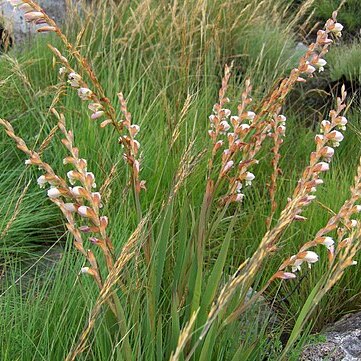Plants (250-)350-900(-1200) mm high. Corm subglobose to depressed-globose, 18-30 mm diam.; tunics leathery to ± coarsely fibrous. Stem erect below, usually flexed outward above sheath of uppermost leaf, simple or 1-to 3-branched. Leaves 4 to 8, mostly basal, sometimes forming a pseudostem, blades narrowly lanceolate to linear, reaching to base of spike or above, 5-12 mm wide, midrib and margins plus two or more pairs of secondary veins hyaline and moderately thickened, cauline leaves progressively shorter blades and uppermost sometimes entirely sheathing. Spike ± erect or weakly inclined, (12)16-to 22(40)-flowered; bracts usually pale green or flushed purple, soft-textured becoming dry and membranous above in fruit, 15-20(-28) mm long and ± 2 internodes long, acute to attenuate, inner shorter than outer and forked apically. Flowers pale to deep pink or light purple, orange-red or cream-coloured, lower lateral, and sometimes lowermost tepals with a band of darker colour across limbs often edged with cream-coloured, unscented; perianth tube obliquely funnel-shaped, 9-17 mm long; tepals broadly ovate, unequal, dorsal largest and arched to hooded over stamens, 18-22 x 10-12 mm, upper laterals directed forward and curving outward above, 18-20 x 16-18 mm, lower 3 tepals ± straight and directed downward, united below for 2-3 mm, narrowed into channelled claws below, lower laterals 12-16 x 5-7 mm, lower median 15-20 x 12 mm. Filaments 12-14 mm long, exserted 6-7 mm from tube; anthers 7-8 mm long, pale lilac to purple; pollen whitish to pale yellow. Style arching over the filaments, usually dividing opposite lower half of anthers, branches ± 3 mm long, seldom reaching past middle of anthers. Capsules obovoid, 9-12(-14) mm long, 3-lobed above and retuse. Seeds elliptic, broadly winged, 4-6 x 2.5-4.0 mm.
Perennial herb, geophyte, 0.2-1.2 m high; corm with coriaceous to ± fibrous tunics; stem erect below, flexed above. Leaves 4-8, usually emerging at flowering time, 5-12 mm wide; midribs, margins and 2 or more pairs of secondary veins hyaline and thickened. Bracts usually pale green or flushed purple, apically forked. Inflorescence 16-22-flowered, ± inclined; flowers pale to deep pink or light purple, occasionally orange or cream-coloured; perianth tube obliquely funnel-shaped, cylindric below, widening and recurving outward near apex; tepals broadly ovate, unequal, the dorsal largest and arched to hooded over stamens. Stamens exserted; anthers pale lilac to purple; pollen whitish to pale yellow. Ovary obovoid, 3-lobed, retuse. Flowering time Dec.-Mar.
Flowers pale to deep-pink or purple, the lower lateral and sometimes the lowermost tepals each with a dark band of colour across the lower half of the limbs, sometimes the dark band edged with cream; perianth tube c. 8 mm long, curved and funnel-shaped, cylindric below, widening and curving outward in upper part; tepals unequal, the uppermost 20–22 × c. 8 mm (often less when dry), larger than the others and arched over the stamens, the upper lateral tepals 18–22 mm long, directed forward and curving outward in the upper half, the lower 3 more or less straight and directed downward, united basally for 2–3 mm, the lateral tepals 12–15 mm, and the lowermost 16–20 mm long.
Foliage leaves 4–8, either few and emergent at flowering time, then the stem bearing only 1–2 cauline and sheathing leaves and 2 laminate basal leaves, or with several basal laminate leaves and 2–3 cauline leaves, these with progressively shorter blades and the upper sometimes entirely sheathing; blades narrowly lanceolate to linear, exceeding the spike in short-stemmed plants, or reaching to about the base of the spike in tall plants, 5–12 mm wide, the midrib and margins hyaline and moderately thickened.
Cormous geophyte, up to 1 m high. Leaves 4-8 or several; blade linear, yellowish green, with raised yellow ribs and margins. Flowers: in a 16-22-flowered spike; bracts 12-40 mm long; anthers 7-8 mm long, pale lilac to purple; perianth 23-38(-40) mm long, lower lateral lobes short with a broad dark blotch near apex, pink, red, orange, mauve, purple or white; Feb.-Apr.
Spike with the main axis (6)12–22-flowered, the branches with fewer flowers; bracts 12–18 mm long, usually pale-green or flushed purple, soft-textured initially, becoming dry and membranous above (in fruit often translucent light red-brown), more or less obtuse to subacute, usually apiculate, the inner slightly shorter than the outer and 2-apiculate.
Cormous herb, up to 1 m high. Leaves sclerotic, yellowish green, linear with raised yellow ribs and margins. Lower lateral lobes of perianth short with a broad dark blotch near apex. Flowers pink, red, orange, mauve, purple or white.
Style usually dividing opposite the lower half of the anthers; style branches c. 2 mm long, seldom extending past the middle of the anthers.
Plants (25)40–90(120) cm high, sometimes with up to 5 stems per corm.
Corms 2–3 cm in diameter; tunics coriaceous to coarsely fibrous.
Filaments c. 12 mm long, exserted for 6 mm; anthers 7–8 mm long.
Capsules 9–12(14) mm long, obovoid.
Stem simple or 1–3(5)-branched.

